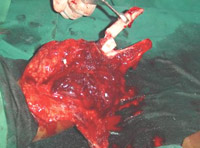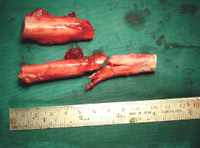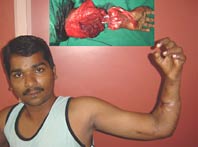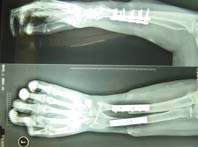Replantation remains better than prostheses or amputation in some cases
Surgeons present their replantation results over 5-year period, offer recommendations for success.
 WASHINGTON – Although major replantations are being performed less often, surgeons should still consider them in cases where the procedure would provide better quality of life than revision amputation, according to Indian researchers.
WASHINGTON – Although major replantations are being performed less often, surgeons should still consider them in cases where the procedure would provide better quality of life than revision amputation, according to Indian researchers.
S. Raja Sabapathy, MCh, FRCS, and his colleagues at Ganga Hospital in Coimbatore, India, found good results and only two failures in 22 major replantations performed at their center from 1997 to 2002.
“In amputations distal to the wrist, if you are not able to replant, reconstruction options are available. But in proximal amputations, reconstructive options are not available,” Sabapathy said at the American Society for Surgery of the Hand 61st Annual Meeting. “A replanted limb almost always is better used than the best available prosthesis.”
Patient evaluation
 Sabapathy and his colleagues evaluated patients using Chen’s criteria at a minimum 2-year follow-up. Patient age ranged from 12 to 56 years old.
Sabapathy and his colleagues evaluated patients using Chen’s criteria at a minimum 2-year follow-up. Patient age ranged from 12 to 56 years old.
Of the 22 replantations, four were located at the transhumeral level, one through the elbow, six at the proximal forearm, six at the mid-forearm, one at the distal forearm and four were proximal to the wrist, Sabapathy said.
Injury mechanisms included seven crush injuries, three avulsions and 10 crush/avulsions combined. Only two injuries were caused by guillotine.
Twelve replantations underwent at least one secondary procedure, and the patients improved functionally with each procedure, Sabapathy said. All patients required at least 1 year of therapy.
According to Chen’s criteria, “Of the 20 surviving cases … 12 of them fell into Grade I or Grade II categories and only two of the 20 fell into the poor category,” Sabapathy said. The researchers classified six replantations as Grade III.
Although Grade IV patients did not have useful function in the limb, they would prefer not to undergo secondary amputation, Sabapathy said.
Of the two failed replantations, one was a crush amputation at the mid-forearm that failed on the operating table. Surgeons had to amputate the other – an arm replant – at 4 days postoperative because of systemic complications.
|
Images: Sabapathy SR |
Surgical procedure
During replantation, Ganga Hospital surgeons internally fixed patients’ bones, allowing 5- to 10-cm shortening.
“Bone shortening is the key,” Sabapathy said. “If you shorten the bone, it avoids the need for vein grafts, nerve grafts, [soft tissue coverage] and makes the whole procedure a lot faster. Up to 10 cm of shortening has not created any functional or cosmetic problems in our patients.”
Sabapathy said single bone fixation in complex injuries, such as a radius-to-radius fixation, allows patients to usefully retain pronation and supination.
The surgeons primarily repaired as many vessels as possible, but in two replantations, they had to graft the nerves later. In these cases, the surgeons placed the distal nerve end subcutaneously during replant, allowing them easier access to graft the nerves later, Sabapathy said.
The researchers found that ischemia time and volume of ischemic mass are two predictive factors of safety in replantations. In this series, ischemia time ranged from 180 minutes to 600 minutes.
To determine whether the patient would undergo an unacceptable time of ischemia during the operation, the researchers proposed that if the patient’s thumb is stiff or not moving well, replantation is not safe.
Researchers also recommended performing anastomosis of venae comitantes and subcutaneous veins to reduce post-clamp release bleeding. As part of their protocol, the surgeons gave the patients brachial blocks as soon as they arrived.
|
|
|
For more information:
- Sabapathy SR, Venkatramani H, Dheenadayalan J, Rajasekaran S. Technical considerations and functional outcome of 22 major replantations. #5. Presented at the American Society for Surgery of the Hand 61st Annual Meeting. Sept. 7-9, 2006. Washington.




